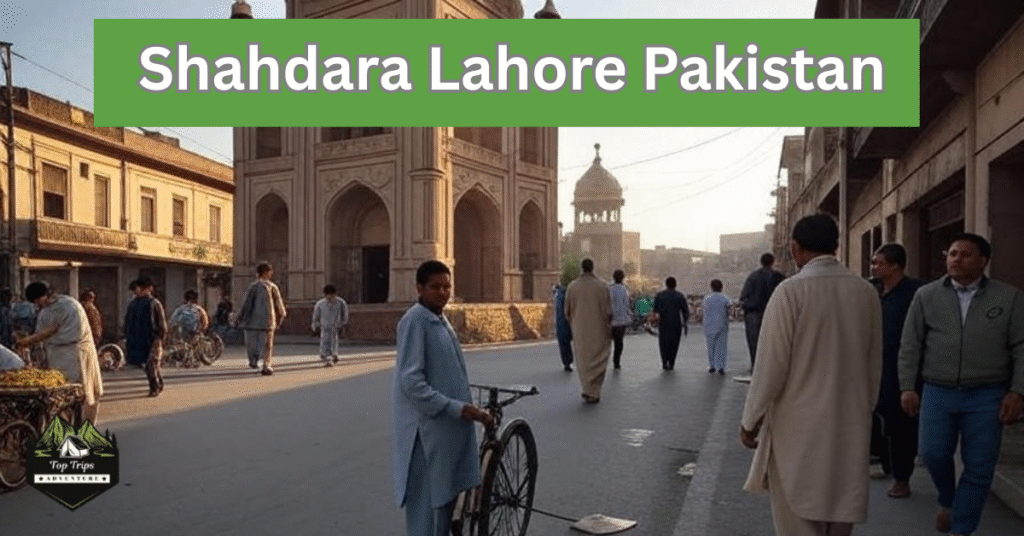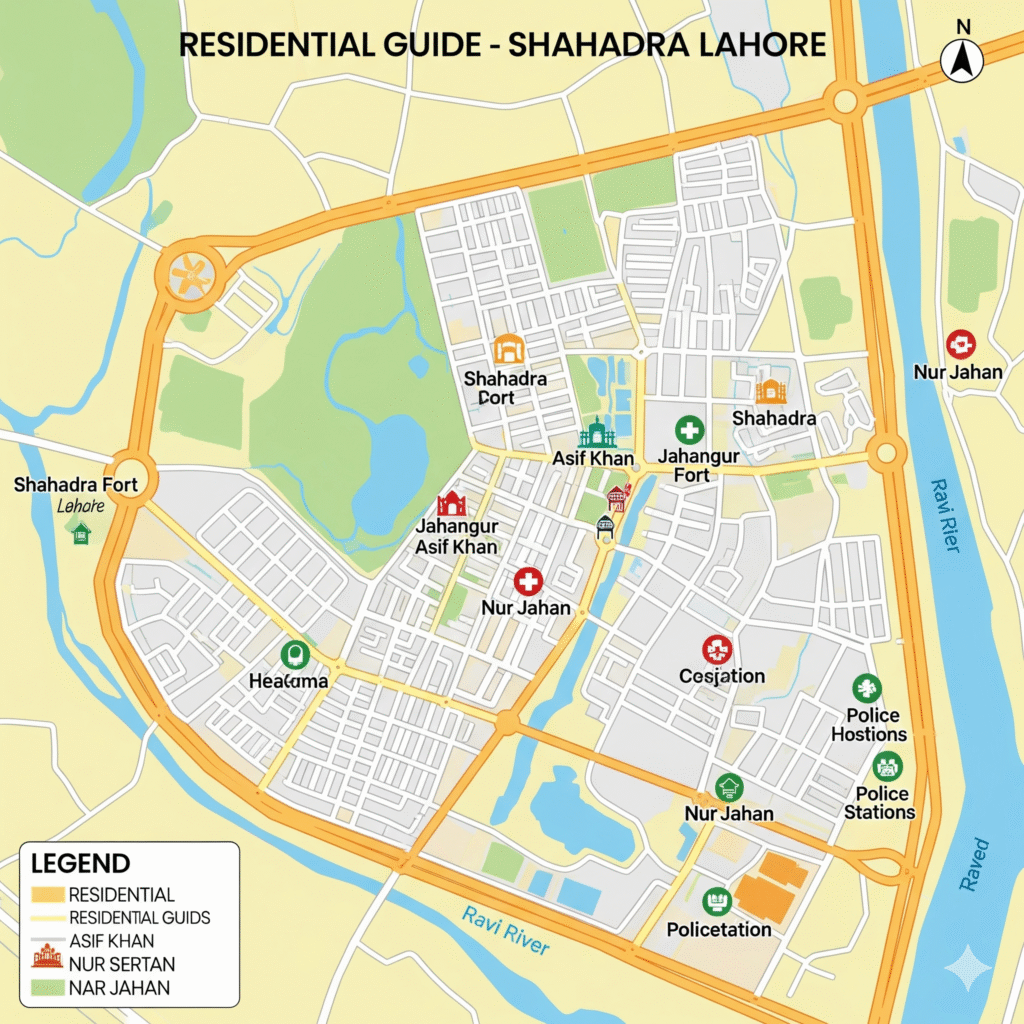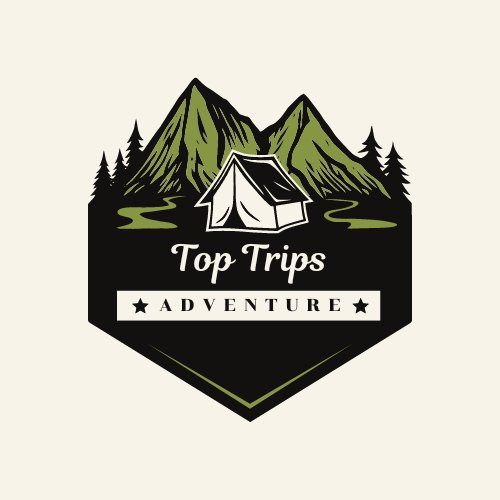Table of Contents
Shahdara Lahore: A Historic Place
-
Location:
Shahdara is located on the right bank of the Ravi River, directly opposite the city of Lahore. -
Historical Entry Point:
In the past, it was the main gateway to Lahore from Kabul and Kashmir. -
Bagh-e-Dilkhusha:
Queen Noor Jahan chose this area to build a beautiful garden called Bagh-e-Dilkhusha. -
From Gardens to Tombs:
-
Between 1527–1645 A.D., Shahdara changed from a place of pleasure gardens to a royal funerary site.
-
This changed the use and character of the land.
-
-
Royal Tombs Built Here:
-
Emperor Jahangir’s Tomb – built in 1627 A.D.
-
Asif Khan’s Tomb (Noor Jahan’s brother) – built in 1641 A.D.
-
Noor Jahan’s Tomb – built in 1645 A.D.
-
-
Special Layout of the Tombs:
-
The tombs are built in a way that they face each other and share a common garden/landscape.
-
This design shows a connected royal era, similar to how tombs are arranged in the Valley of the Kings in Egypt.
-
Why Shahdara Matters Today?
In modern Pakistan, Shahdara represents a unique blend of:
- Historical preservation with active conservation of Mughal monuments
- Urban development through metro connectivity and infrastructure projects
- Real estate investment opportunities in Lahore’s expanding metropolitan area
- Cultural tourism attracts visitors to world-class architectural sites
Historical Significance: Shahdara’s Mughal Legacy
The Royal Cemetery of the Mughals
Shahdara Bagh (شاہدرہ باغ) houses Pakistan’s most important collection of Mughal imperial tombs, making it a UNESCO tentative World Heritage Site since 1993.
Tomb of Emperor Jahangir (1627-1637 CE)
- Construction Cost: 1 million rupees (17th century)
- Architecture: Single-story square building with Charbagh garden design
- Unique Features: 99 attributes of Allah inlaid in precious stones
- Cultural Impact: Featured on Pakistani currency notes
Tomb of Empress Nur Jahan (1645 CE)
- Historical Importance: Only Mughal empress whose name appeared on imperial coins
- Architecture: Red sandstone structure with marble inlay work
- Construction Time: 4 years at a cost of 0.3 million rupees
- Notable Feature: Houses both Nur Jahan and her daughter Ladli Begum
Tomb of Asif Khan (1641 CE)
- Significance: Brother of Nur Jahan and father of Mumtaz Mahal
- Design: Octagonal structure with bulbous dome
- Construction: Built by Shah Jahan over four years
Akbari Sarai: The Ancient Caravanserai
- Original Purpose: Traveler’s inn and mail station (dāk chowkī)
- Capacity: 180 cells (khanaha) across 12 acres
- Services: Free lodging, fodder, medical care, and fresh water
- Historical Timeline: Begun under Islam Shah Suri (1550s), completed under Shah Jahan

Lesser-Known Historical Sites
Baradari of Kamran Mirza
- Originally built on the Ravi River bank
- Now stands as an island due to river course changes
- Represents early Mughal recreational architecture
Tomb of Princess Dohita Un Nissa Begum (1651-1697)
- Small garden tomb of a Mughal princess
- Often overlooked by mainstream tourism
- Represents the broader royal family burial tradition
Geographic Location Of Shahadra Lahore
Strategic Position in Lahore Metropolitan
- Location: Northern edge of Lahore, across the Ravi River from Walled City
- Major Highway: Situated along the Grand Trunk Road (GT Road)
- Distance from City Center: 12-15 kilometers from Lahore’s commercial heart
- Neighboring Areas: Connects to Gujranwala, Sheikhupura, and Kala Shah Kaku
Modern Transportation Infrastructure
Orange Line Metro Train Connection
- Shahdara Station: Northern terminal of Lahore’s first metro line
- Journey Time: 45 minutes to southern Lahore
- Daily Capacity: Serves thousands of commuters
- Economic Impact: Significant boost to local real estate values
Public Transport Options
- Metrobus connectivity to central Lahore
- Railway station serving national routes
- Abundant rickshaw and taxi services
- Major bus terminal for intercity travel
Real Estate Market Analysis
Property Investment Opportunities
Residential Real Estate Trends
- Average Property Prices: PKR 15-30 lakh per marla (2024 estimates)
- Popular Housing Types:
- 5 marla houses (PKR 25-40 lakh)
- 10 marla houses (PKR 45-70 lakh)
- 1 kanal properties (PKR 80 lakh – 1.2 crore)
- Growth Rate: 8-12% annually due to metro connectivity
Commercial Investment Potential
- Retail Spaces: Growing demand near metro stations
- Office Complexes: Emerging business district development
- Industrial Proximity: Close to the Kala Shah Kaku industrial zone
- Tourism Revenue: Heritage site proximity boosts the hospitality sector
Investment Advantages
- Metro Connectivity: Orange Line dramatically improved accessibility
- Government Development: Ongoing infrastructure improvements
- Historical Tourism: Steady visitor influx supports service businesses
- Affordable Entry Point: Lower prices than the central Lahore areas
Popular Residential Areas Within Shahdara
- Jia Musa: Established residential locality with good amenities
- Shahdara Town: Dense urban area with mixed residential/commercial use
- Railway Colony: Government housing near railway infrastructure
- Metro Station Vicinity: New developments capitalizing on transit access
Educational Infrastructure and Institutions
Schools and Colleges
- Shahdara Degree College: Major higher education institution
- Government Schools: Multiple primary and secondary schools
- Private Education: Growing number of quality private institutions
- Technical Training: Vocational institutes serving local workforce needs
Educational Accessibility
- Metro Connectivity: Students can easily access universities throughout Lahore
- Library Facilities: Public and institutional libraries available
- Digital Infrastructure: Improving internet connectivity for online education
Shopping, Dining, and Entertainment
Traditional Markets and Bazaars
- Main Bazaar Shahdara: Traditional goods, textiles, and spices
- Food Street Culture: Local tea stalls and traditional eateries
- Handicrafts: Traditional Punjabi crafts and souvenirs
- Grocery Markets: Daily necessities and fresh produce
Modern Retail Development
- Shopping Centers: Small to medium-sized malls near metro station
- Branded Outlets: Increasing presence of national retail chains
- Service Businesses: Banks, telecom centers, and professional services
Tourism and Recreation
Heritage Tourism Attractions
Shahdara Point: Riverside Recreation
- Location: Scenic spot along Ravi River
- Activities: Evening walks, family picnics, photography
- Best Times: Sunset viewing and weekend family gatherings
- Development Plans: City authorities developing organized riverside park
Cultural Tourism Infrastructure
- Guided Tours: Available for historical sites
- Tourist Information: Basic facilities at major monuments
- Photography: Popular destination for wedding and cultural photography
- Educational Tours: School and university groups regularly visit
Religious and Spiritual Sites
- Historic Mosques: Several dating back to Mughal era
- Shrines: Local spiritual centers attracting devotees
- Community Centers: Active religious and cultural activities

Climate and Best Visiting Times
Seasonal Weather Patterns
- Summer (May-July): Hot and dry, temperatures above 40°C
- Monsoon (July-September): Occasional heavy rainfall, cooler temperatures
- Winter (December-February): Mild, temperatures 5-20°C
- Spring (March-April): Ideal weather for outdoor activities
- Autumn (October-November): Pleasant temperatures, clear skies
Optimal Tourism Seasons
- Best Months: March-April and October-November
- Photography: Spring blooms in Jahangir’s tomb gardens spectacular
- Heritage Tours: Cool weather ideal for extended site visits
- Avoid: Peak summer months for outdoor activities
Economic Development and Future Prospects
Industrial and Commercial Growth
- Logistics Hub: Strategic location on GT Road
- Metro Impact: Significant economic boost from Orange Line
- Tourism Revenue: Growing heritage tourism sector
- Service Industry: Expanding retail and hospitality businesses
Government Development Initiatives
- Infrastructure Projects: Road widening and utility improvements
- Heritage Conservation: Ongoing restoration of historical monuments
- Urban Planning: Systematic development of residential areas
- Public Amenities: Parks, healthcare facilities, and civic services
Living in Shahdara: Residential Guide
Lifestyle and Community
- Cultural Diversity: Mixed communities representing various backgrounds
- Social Life: Strong neighborhood connections and community events
- Cost of Living: Significantly lower than central Lahore
- Amenities: Growing availability of modern conveniences
Utilities and Infrastructure
- Electricity: Regular supply with occasional load shedding
- Water: Municipal supply with private bore wells as backup
- Internet: Broadband availability improving rapidly
- Healthcare: Basic medical facilities with major hospitals accessible via metro
Safety and Security
- Crime Rates: Generally safe residential area
- Police Presence: Regular patrolling and community policing
- Traffic Safety: Improving with infrastructure development
- Emergency Services: Accessible via main Lahore emergency systems

Transportation Guide Getting To and Around Shahdara
From Major Lahore Areas
Distance and Travel Times
- Khayaban-e-Jinnah: 28-30 km, 45-60 minutes by car
- Mall Road: 15-20 km, 30-40 minutes via metro
- Gulberg: 20-25 km, 35-50 minutes via Orange Line
- Defence: 25-30 km, 50-70 minutes depending on route
Public Transport Options
- Orange Line Metro: Most efficient for north-south travel
- Metrobus: Connections to various city areas
- Local Buses: Extensive network covering nearby areas
- Ride-hailing: Uber, Careem, and local apps available
Intercity Connections
- Railway Station: Direct trains to major Pakistani cities
- Bus Terminal: Services to Punjab and other provinces
- Airport Access: Allama Iqbal International Airport is 45 minutes away
Conclusion
Shahdara Lahore blends historical preservation with modern urban development, safeguarding Pakistan’s significant Mughal heritage while evolving into a residential and commercial hub. Metro connectivity has boosted real estate, economic growth, and quality of life, honoring its legacy as the “King’s Way” for commuters, tourists, and residents alike.
For investors, history enthusiasts, or those seeking a unique Lahori experience, Shahdara offers a glimpse into Pakistan’s past, present, and future. Its strategic location, rich heritage, and ongoing development make it a promising area for property investment, heritage tours, or a vibrant place to call home.

